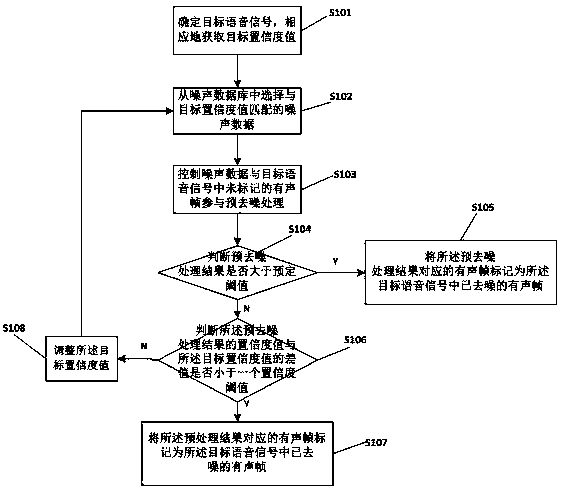Iterative denoising method based on speech recognition and chip
A speech recognition and iterative technology, applied in the field of robotics, can solve problems such as inclusion of external noise, affecting the effect of speech recognition, and low speech recognition efficiency, and achieve the effect of improving the denoising rate
- Summary
- Abstract
- Description
- Claims
- Application Information
AI Technical Summary
Problems solved by technology
Method used
Image
Examples
Embodiment approach
[0014] refer to figure 1 As shown, the embodiment of the present invention provides a speech recognition-based iterative denoising method, as an implementation of the iterative denoising method, including:
[0015] Step S101, acquire a voice signal from a specific direction from the microphone array, and determine the target voice signal based on the information domain analysis of the database pre-stored by the voice engine, so as to achieve directional voice pickup and reduce external noise interference. Then go to step S102. The target voice signal includes the control command orally spoken by the user or the voice data input by the machine. Correspondingly, the target confidence value is obtained based on the target voice signal. The degree of authenticity information of the speech signal can be used to represent the value of the credibility of the speech preliminary recognition result. In order to reduce misjudgment, the correctness of the recognition result is judged acc...
PUM
 Login to View More
Login to View More Abstract
Description
Claims
Application Information
 Login to View More
Login to View More - R&D
- Intellectual Property
- Life Sciences
- Materials
- Tech Scout
- Unparalleled Data Quality
- Higher Quality Content
- 60% Fewer Hallucinations
Browse by: Latest US Patents, China's latest patents, Technical Efficacy Thesaurus, Application Domain, Technology Topic, Popular Technical Reports.
© 2025 PatSnap. All rights reserved.Legal|Privacy policy|Modern Slavery Act Transparency Statement|Sitemap|About US| Contact US: help@patsnap.com

